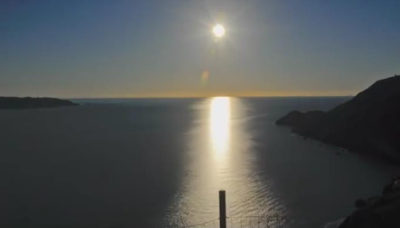14. Because an experiment could see a light across 108 miles of St George’s Channel the Earth cannot be a sphere
“The Lieutenant-Colonel Portlock experiment used oxy-hydrogen Drummond’s lights and heliostats to reflect the sun’s rays across stations set up across 108 miles of St. George’s Channel. If the Earth were actually a ball 25,000 miles in circumference, Portlock’s light should have remained hidden under a mile and a half of curvature.”
Dubay uses faulty trigonometry. Using the correct calculations we see that this scenario is perfectly possible on a spherical Earth. This is essentially the same proof as 13 and fails for the same reason.
Eric Dubay does not give enough information for calculations, but an account of the experiment by Mr Rowbotham in Zetetic Astronomy (http://the-uncredibles.tumblr.com/post/130629473404/200-pensb-14-lt-col-portlock) allows the following calculations.
The light was set up on mount Kippure in Ireland which has a height of 2,484 feet. 108 miles, and without taking typical refraction into account, the observation point in the Preseli range of hills would need to be at least 1471 feet. There are 3 peaks over 1500 feet in the Preseli range, which means that it is perfectly possible for the experiment to have observed the light on a spherical earth.
For details on how to calculate the visibility of an object at a distance see: https://flatearthinsanity.blogspot.co.uk/2016/07/derivation-for-height-of-distant.html
< Prev 11-20 Next >
Dubay uses faulty trigonometry. Using the correct calculations we see that this scenario is perfectly possible on a spherical Earth. This is essentially the same proof as 13 and fails for the same reason.
Eric Dubay does not give enough information for calculations, but an account of the experiment by Mr Rowbotham in Zetetic Astronomy (http://the-uncredibles.tumblr.com/post/130629473404/200-pensb-14-lt-col-portlock) allows the following calculations.
The light was set up on mount Kippure in Ireland which has a height of 2,484 feet. 108 miles, and without taking typical refraction into account, the observation point in the Preseli range of hills would need to be at least 1471 feet. There are 3 peaks over 1500 feet in the Preseli range, which means that it is perfectly possible for the experiment to have observed the light on a spherical earth.
For details on how to calculate the visibility of an object at a distance see: https://flatearthinsanity.blogspot.co.uk/2016/07/derivation-for-height-of-distant.html
< Prev 11-20 Next >




Comments
Post a Comment